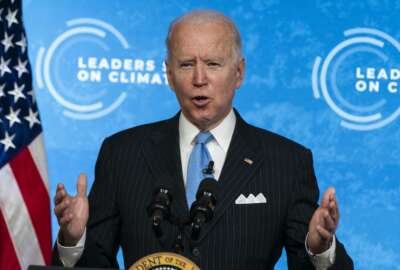The Biden administration is setting a decades-long vision to eliminate carbon emissions from federal buildings and vehicles.
President Joe Biden, as part of an executive order he signed Wednesday, expects agencies to reach net-zero greenhouse gas emissions across all federal operations by 2050, including a 65% reduction by 2030.
The Biden administration expects the federal government’s purchasing power, as directed under this executive order, will support private industry’s capacity to produce electric vehicles and batteries, as well as accelerate job growth in sustainable manufacturing and engineering.
“As the single largest landowner, energy consumer, and employer in the nation, the federal government can catalyze private sector investment and expand the economy and American industry by transforming how we build, buy, and manage electricity, vehicles, buildings, and other operations to be clean and sustainable,” the executive order states.
A separate memo from the White House’s Council on Environmental Quality, Office of Management and Budget and Climate Policy Office states the administration is working guidance that, once released, will give agencies 90 days to set targets that will put them on a path to achieving the most of the executive order’s long-term goals.
The executive order builds on the administration’s priorities in the Build Back Better Act, which the House passed in November, but has yet to move forward in the Senate.
The infrastructure spending package would currently give the Postal Service $6 billion to invest in electric delivery vehicles and charging stations, and would give the General Services Administration $3 billion to purchase electric vehicles through September 2026.
The legislation also gives GSA more than $3 billion to improve energy efficiency and reduce the carbon footprint of federal buildings.
The executive order sets the goal of the federal government purchasing 100% zero-emission vehicles by 2035, and purchasing only zero-emission “light duty” vehicles by 2027.
The administration is directing all agencies to develop a zero-emission fleet strategy that addresses right-sizing their inventory of vehicles, purchasing more electric and zero-emission vehicles and developing charging stations and other necessary infrastructure.
This latest executive order builds on several other White House policies. President Joe Biden, in his first month in office, signed an executive order directing agencies to move the entire federal vehicle fleet to electric and zero-emission vehicles.
Administration officials, however, acknowledge agencies have a long way to go before moving the needle on the administration’s goals.
White House National Climate Advisor Gina McCarthy, the former EPA administrator under the Obama administration, said this summer that less than 1% of the federal fleet are plug-in electric vehicles and that agencies bought only 200 electric vehicles last year.
The EO directs agencies to make the federal building portfolio zero-emission by 2045, and reach a 50% reduction in greenhouse gas emissions by 2032, compared to baseline levels from 2008. It also directs agencies to make federal buildings more energy and water-efficient, as well as more resilient against climate change.
The EO also creates a Buy Clean Task Force, led by OMB and CEQ to promote the use of lower-emission construction materials.
The executive order directs agencies to transition to 100% carbon pollution-free electricity by 2030, and ensure at least half of it comes from locally supplied clean energy sources.
To meet this goal, the administration is telling agencies to lease or otherwise leverage real-estate assets – such as rooftops, parking lots, garages and excess land — in ways that would produce clean energy.
The administration is also directing chief sustainability officers to make progress on the executive order’s goals. Biden in February appointed Andrew Mayock, former Office of Management deputy director for management during the Obama administration, to serve as federal chief sustainability officer.
According to the Office of the Federal Chief Sustainability Officer, at least 50 agencies have their own chief sustainability officers.
The EO directs GSA to track greenhouse gas emissions, emissions reduction targets and other sustainability-related actions from major federal suppliers, and will work with CEQ to reduce emissions from the federal supply chain.
GSA Administrator Robin Carnahan said the executive order gives the federal government an opportunity to reduce emissions and support clean energy industries.
“Right now we have a massive opportunity to create millions of clean energy jobs, save taxpayer money through reduced energy costs, and build a more sustainable future for generations of Americans,” Carnahan said. “Today’s actions demonstrate how GSA and our federal partners will move forward with a bold vision that meets this moment in history by harnessing the power of American ingenuity and innovation.”
The executive order also presents opportunities to train the federal workforce. It gives the Office of Personnel Management 90 days to create a report that outlines ways to expand environmental sustainability and climate adaptation training for federal employees.
The administration is telling OPM to consult with GSA, the Energy Department, the Environmental Protection Agency and federal employee unions in drafting the report.
GSA Deputy Administrator Katy Kale, speaking at the most recent National Climate Task Force meeting, said the agency will ensure its federal customers have the support they need to buy electricity, vehicles and services from sustainable sources.
“From day one, GSA has been excited about revitalizing governmentwide sustainability, and we are now positioned to help agencies reach these ambitious goals,” Kale said.
House Oversight and Reform Committee Chairwoman Carolyn Maloney said the executive order builds on many of the clean-energy investments in the Build Back Better Act, and puts agencies on a path to reduce their carbon footprint.
“Today’s executive order leverages the federal government’s unique role as the nation’s largest employer and purchaser of goods and services to make real progress in the fight against climate change,” Maloney said. “As chairwoman of the Oversight Committee, I’ve fought to make key elements of the President’s climate plan a reality, from electrifying the federal fleet, to advancing green buildings and green procurement, to promoting environmental justice. The security of our country and future generations relies on a coordinated, whole-of-government response to the climate crisis.”
Copyright
© 2024 Federal News Network. All rights reserved. This website is not intended for users located within the European Economic Area.





